First Robotics Introduction to Electrical Systems - PowerPoint PPT Presentation
1 / 39
Title: First Robotics Introduction to Electrical Systems
1
First RoboticsIntroduction to Electrical Systems
- Team UltravioletSouthwest High School
- MN SPLASH
- December 6, 2008
2
How Do We Make Sense of This?
3
Presentation Agenda
- Direct Current (DC) Basics
- Why Wiring Rules?
- First Robotics Electrical System Overview
- Electrical Safety
- Questions
4
Direct Current (DC) Basics
5
Bottom LineWhat Does the Robot Electrical System
Do?
- Stores Energy (Battery)
- Uses Stored Energy to Do Work (Motors, Solenoids,
Etc.) - Makes Decisions (Robot Controller)
6
Whats Up With Voltage?
- Battery Stores Energy
- Volts Measures Pressure of the Stored Energy
- Volts Electrical Potential Energy
Water Pressure Height Electricity Pressure
Volts
7
Whats Up With Current?
- Current Is Flow of Electrical Charges (Electrons)
- Current Flows Due to the Pressure of Voltage
- Current Flow Transports Electrical Energy
Water Flow Gallons Per Minute Current Flow
Amps (Amount of Electrical Charge Per Second)
8
Whats Up With Resistance?
- Resistance is Restriction to Current Flow
- Volts, Resistance and Current have a Linear
Relationship - Ohms Law V I x R
Valve Closed Less Flow Valve Open More
Flow High Resistance Less Current Low
Resistance More Current
9
What Happens to the Energy?
Moving Electrons Through Resistance Converts
Electrical Energy To Heat Energy Power is the
Amount of Energy Used Per Second
I
_
Electrical Power P V x I
V
R
V Voltage 12V I Current 0.5A R
Resistance 24 Ohms P Power 6 Watts
10
Electric Energy Conversions
- Electric Energy to Mechanical Energy (The Robot)
- Electric Energy to Heat Energy
- Electric Energy to Light Energy
11
Why Wiring Rules?
12
Wiring Rules Provide For Electrical Safety
- Wire Size Rules
- Circuit Breaker Rules
- The Robot Must Pass Electrical Inspection
Wiring Rules Are The Electrical Codes for First
Robots
13
Rules Designed to Protect Wires From Overheating
Wire Resistance
- All Wires Have Some Resistance
- Bigger Wire Less Resistance
- Smaller Wire More Resistance
- Current Through a Resistance Generates Heat
- So, High Current Melts Insulation, Causes Fires
12V -
I
Wire Resistance
Load Resistance
If Current is Too High The Wire Overheats
14
Main Power Wires Carry More Current So They Are
Bigger
12V -
IT
- Battery Wire Current is the Sum of All Load
Currents - IT I1 I2 I3
- Use 6 AWG For Main Power Distribution Wires
IT
I1
I2
I3
15
Battery With Big Wires
16
Load Failures and Short Circuits Cause Excessive
Current
12V -
12V -
High Current
High Current
Load Failure
Short Circuit
17
Circuit Breakers Open The Circuit On High Current
12V -
- 120 A Circuit Breaker - 6 AWG or Larger
- 40 A Circuit Breaker - 12 AWG or Larger
- 30 A Circuit Breaker - 14 AWG or Larger
- 20 A Circuit Breaker - 18 AWG or Larger
40 A
Circuit Breaker Opens If Current gt 40 Amps
18
First Robotics Electrical System Overview
19
First Robotics Uses a 12 VDC Electrical System
- Powered By 12V Battery
- Robotics Controller
- Robot Drive Motors Variable Speed, Reversible
- Robot Arms and Lifts Single Speed. Reversible
if Needed - Pneumatic Valves Solenoids
- Sensors
20
First Battery and Battery Connector No
Substitutions
Battery
12V -
6 AWG
Battery Connector
6 AWG
21
Main Circuit Breaker Ahead of All Loads
12V -
120 A
6 AWG
6 AWG
22
Main Circuit Breaker Close-UP
23
All Loads Fed From Main Power Distribution
Assembly
12V -
6 AWG
6 AWG
120 A
-
24V (For Controller)
Internal Electronics
12V (For WIFI)
5V (For Camera)
8 x 40A Breakers and Terminals
12 x 20-30A Breakers and Terminals
40 A
-
24
Power Distribution Assembly Side View
25
First Robotics Controller is the Robot Brain
26
Robot Controller Connection ToPower Distribution
Assembly
12V -
6 AWG
6 AWG
120 A
-
24V
Internal Electronics
Controller Module
12V (For WIFI)
5V (For Camera)
27
Robot Drive Uses Motor Speed Controller and Motor
28
One Motor Per Circuit Breaker Circuit Breaker
Size Depends on Motor Load
PMW Cable To Robot Controller
40 A
-
-
Speed Controller
Output -
M
Power Distribution Assembly
-
Load
29
Motor Controller Close-UP
30
New Motor Controller Close Up
31
Use a Spike Relay to Control Other Motors and
Miscellaneous Devices
32
Spike Relay Close-Up
33
Spike Relay Protected By 20 A Circuit Breaker (2
Non-Motor Loads)
PMW Cable To Robot Controller
20 A
-
-
M
Load
M-
Load
Spike Relay
Power Distribution Assembly
34
Pneumatic Solenoid Close-Up
35
Only One Motor Per Spike Relay
PMW Cable To Robot Controller
20 A
-
-
M
M-
M
Spike Relay
Power Distribution Assembly
-
36
Electrical Safety
37
Electrical Hazards
- Electric Shock
- Burns
- Stop Breathing
- Heart Fibrillation
- Fire, Explosion
- Burns
- Hazardous Fumes
- Tools
- Soldering Iron (Burns)
- Pliers and Wire Cutters (Pinches and Cuts)
38
Precautions Against Electrical Hazards
- Never Work on the Robot With The Electrical
System Powered - Disconnect Battery (Best)
- Turn Off Main Circuit Breaker
- Avert Face and Body When Turning On Electrical
System - Wear Protective Equipment
- Eye Protection (Possibly Face Shield)
- Cotton Long-Sleeve, Long-Pants
- Leather Gloves (Possibly Insulating Gloves)
- Avoid Loose Clothing
- Remove Watches, Rings, Necklaces, Ear Rings and
Other Jewelry
39
Questions?































